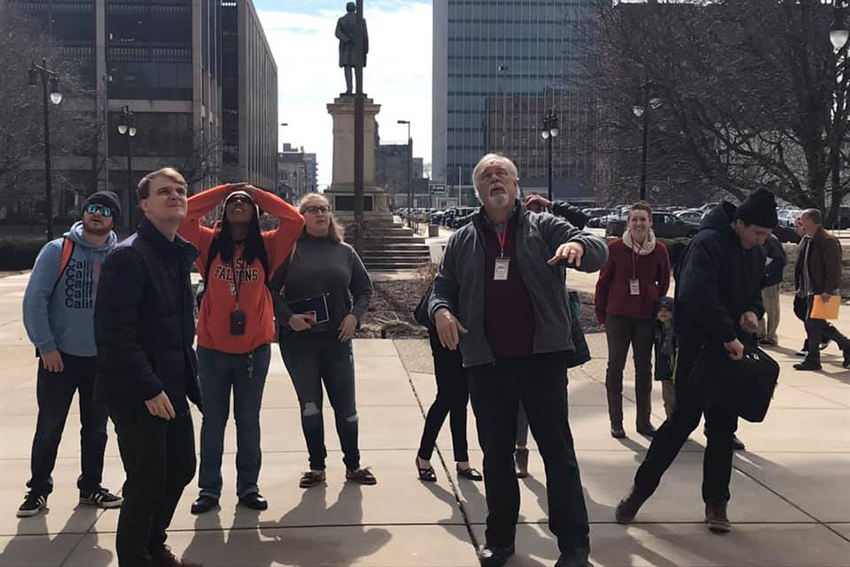Art history exhibition explores ‘Toledo Renaissance’

The Renaissance is known as a time when European culture, art, politics and the economy flourished. Toledo, Ohio, had its own Renaissance in the early 20th century and proclaimed the city as a place of promise. Students in Dr. Allie Terry-Fritsch’s “Critical Issues in Early Modern Art History" seminar this semester explored the architecture and people that shaped Toledo’s identity as a site of renewal through patronage of architecture and art inspired by the Renaissance.
Through focused examination of select Toledo buildings, the students discovered “the nuanced strategies of architectural appropriation that situated early 20th-century residents within a fantasy of the golden age,” Terry-Fritsch said. The histories they uncovered tell an interesting story, she added, “from Lamson’s, the luxury department store, that framed its wares with the insignia of the prestigious labor guilds of Renaissance Florence to the vaudeville theater that transported the Ca’ d’Oro from Venice to downtown Toledo.
“The general themes of their research demonstrated how cities express their desires through architecture,” she said.
The class’s final project, “The Toledo (Ohio) Renaissance” symposium and exhibition, is designed to draw attention to the Renaissance precedents for Toledo’s urban cityscape and instigate reflection on the role that Renaissance culture played in establishing the city, and its citizens as a sophisticated counterpart to the major metropolitan centers of the East Coast. It also highlights the contributions of select Toledoans to the robust arts community of Toledo.
The symposium, from 1 to 3 p.m. May 8 in 1101 Fine Arts Center, will feature a keynote lecture by Dr. Ted Ligabel, professor and director emeritus of Eastern Michigan University’s Historic Preservation Program, and research presentations by the students about Toledo’s “Renaissance” monuments. A reception and the opening of the exhibition in the Dorothy Uber Bryan Gallery lobby will immediately follow the presentations.
The students’ focused examination of select Toledo buildings included visits to local history archives at BGSU’s Center for Archival Collections, Toledo Public Library’s Local History Collection, and the Toledo Museum of Art Reference Library. They learned from local archivists how to read primary sources such as historical maps, titles ad deeds, insurance documents, historical newspapers, museum catalogues and inventories. They also were trained in historical museum display practices and met with museum curators at the Toledo History Museum and Toledo Police Museum who offered the opportunity to discuss exhibition strategies and engage with historical artifacts.
For undergraduate student Roman Brown, the research gave him a foundation that will allow him “to go anywhere and find places to look at the architecture and know there are resources for discovering more information.”
Students Peter Funk of Maumee and Michelle Chamberlin of Perrysburg agreed that they had never taken much interest in Toledo and its architecture despite living in the area for most of their lives. “Now I see the rich history of the area and I will be able to share that with others and take it with me wherever I go,” Chamberlin said.
Grace Nelson and Kari Boroff are the MA graduate students in art history. They agree the experience they have gained in this seminar will serve them well in their careers. Boroff, who wants to work in a museum, said, “The experience has taught me how to curate an exhibition and how to collaborate with others.”
Digital arts student Mitch Taylor used his skills to create the exhibition logo featuring the Toledo skyline and to help develop the website. The buildings and people researched include Burt’s Theatre, Aris Holmes and Kari Boroff; Paramount Theatre, Aris Holmes; Secor Hotel, Mitch Taylor; Lamson’s Department Store, Kari Boroff; Blade Building, Zhaoling Wu and Grace Nelson; Bell Telephone Building, Peter Funk; St. Anne’s Church, Roman Brown; Rosary Cathedral, Emma Barned; University Hall, Zhaoling Wu; Edward D. Libbey House, Michelle Chamberlin; Inlands (the home of Ward D. Canaday), Peter Funk and Grace Nelson.
Support for the exhibition and symposium was made possible by the Division of Art History and the School of Art at Bowling Green State University.
Both the symposium and exhibition are free and open to the public. Any questions may be directed to Dr. Allie Terry-Fritsch at alterry@bgsu.edu
Guests with disabilities are requested to indicate if they need special services, assistance or appropriate modifications to fully participate in this event by contacting Accessibility Services at access@bgsu.edu or 419-372-8495 prior to the event.
Updated: 05/06/2019 01:12PM
